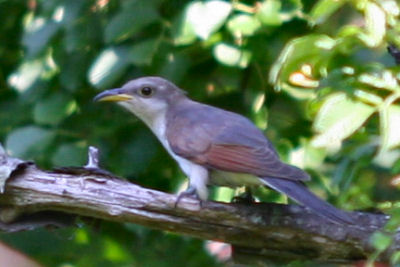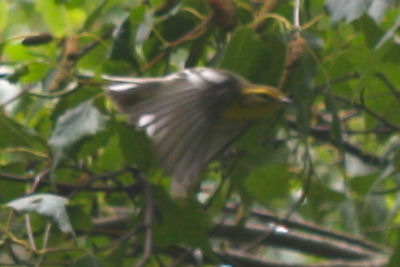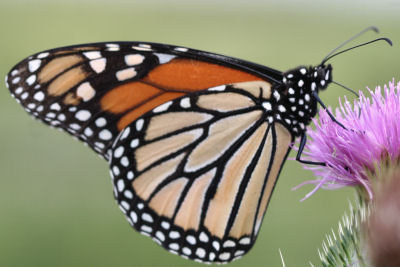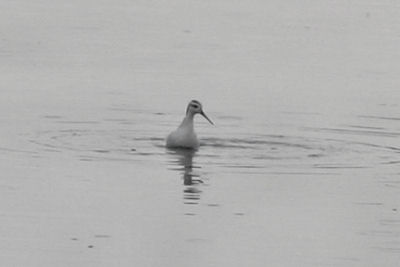As Mike nicely detailed in his post the two of us spent most of Sunday morning on the East Pond of Jamaica Bay Wildlife Refuge looking at and learning about shorebirds at the Jamaica Bay Shorebird Festival. He also mentioned that we didn’t see a Baird’s Sandpiper, a bird that neither of us has ever seen. But there had been one reported over the previous couple of days at Floyd Bennett Field, a mere fifteen minutes from Jamaica Bay.
I’m not sure if it was the sad look on my face because Mike had picked up his life Stilt Sandpiper and I hadn’t added a life bird that convinced him to agree to drive us off in search of a Baird’s Sandpiper or if it was his own eagerness to chalk up a second bird he had never seen but either way we braved the packed Belt Parkway and were soon pulling into the vast expanses of Floyd Bennett Field.
I neglected to take any pictures while we were there but just picture an airport without airplanes that has gone a bit wild and you will know exactly what Floyd Bennett Field looks like. We drove all the way to the end of one runway to where there were some puddles and saw some peeps. And a juvenile Herring Gull. And that was it. No Baird’s. Well, there were lots of Eastern Kingbirds and Northern Mockingbirds but that wasn’t quite what we had anticipated. Back to Jamaica Bay!
Upon our arrival we briefly discussed the idea of rejoining the shorebird festival but they were indoors at presentations. Seeing as our time was limited because we both had places to be we decided that instead of spending what time we had left in a building we would explore the north gardens for migrants…a good decision.
As much as I am starting to enjoy the difficulties inherent in identifying cryptically-colored shorebirds they can’t compare to the wonderful wood-warblers. And what wood-warblers we saw! A male Black-throated Green Warbler was our first of the day but it would be followed by several other species. We were surprised by a Red-breasted Nuthatch, which is not usually present at Jamaica Bay, and a Yellow-billed Cuckoo gave us decent looks through the trees. Mike’s second-ever Blackburnian Warbler took us a second to figure out in the dim light and thick branches but we nailed the ID in short order. It wasn’t the brilliant male in breeding plumage we spotted this spring but it still was a Blackburnian Warbler!

Yellow-billed Cuckoo

Blackburnian Warbler
A quick aside on the cuckoo photo…I actually took it a couple of weeks ago when I was exploring Jamaica Bay with Daisy. When we first saw it it was on the ground and rather distant and for some reason I thought it was a flicker. Daisy, without binoculars, called it a cuckoo and hasn’t let me forget it. Darned amateurs getting things right!
Back to the birding. A Yellow Warbler, a Black-and-white Warbler and a juvenile Baltimore Oriole all appeared in the same tree and then a bird that sounded somehow familiar started singing. It suddenly hit me that it was a White-eyed Vireo, only the fourth time I had ever encountered one, as they don’t breed as far north as Albany. The “chip-slurred song-chip” song is pretty distinctive though, and we managed to track the singing to the bird and heard a second one singing further off. Then Mike found a Red-eyed Vireo, we chased a waterthrush until we were convinced it was a Louisiana Waterthrush, and Mike spotted an American Redstart. That was it for passerine migrants but we spotted a Cooper’s Hawk as we walked out of the gardens to the trail around the West Pond.
The West Pond was actually kind of ho-hum. Sure we saw both Yellow and Black-crowned Night-Herons, American Oystercatchers, Brown Thrashers, Forster’s, Common and Least Terns, Black-bellied Plovers, Osprey, American Wigeons, American Black Ducks, Mute Swans, Mallards, Canada Geese, Barn and Tree Swallows, Double-Crested Cormorants, Snowy and Great Egrets, Great Blue Herons, and other birds I’ve already managed to forget, but that’s really not that impressive for Jamaica Bay. We are, after all, talking about one of the best birding locations in the northeast!

Monarch Butterfly on Great Burdock
And, by the way, the Wilson’s Phalaropes that Mike mentioned in his post brought my New York Year List up to 272. Twenty-eight to go!

spinning Wilson’s Phalarope
Finally, I’ve added a couple more pics from Saturday to my Sanderling post.













I have to say my fave shot is the monarch but I do love the many other wonderful bird pictures you guys are getting! One day I will have to get out to Jamaica Bay to do some birding! I just know that I will get a ton of lifers!
Just be sure to contact us when you come down, Mon@rch.
Jamaica Bay really is a wonderful birding spot.
Mon@rch, to second Mike, definitely drop an email if you’re heading that way…as John says, it is a wonderful birding spot!